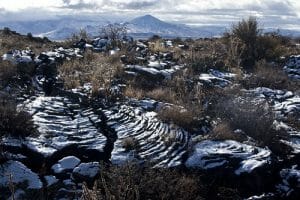Primary Succession Definition
Primary succession is the orderly and predictable series of events through which a stable ecosystem forms in a previously uninhabited region. Primary succession occurs in regions characterized by the absence of soil and living organisms.
It begins with the appearance of pioneer species – lichen, mosses and fungi – that can grow on rocks and exposed land. These are small, simple organisms that can survive harsh conditions, fix inorganic carbon and nitrogen, and accelerate the process of weathering. As they die and decompose, their organic matter becomes the foundation for a thin layer of soil. Pioneer species pave the way for more complex communities of organisms, because the pioneers have altered the physical environment to make it more habitable. Once grasses and weeds begin to grow, soil formation is accelerated and more animal species begin to appear. The environment retains moisture, and ideal conditions are created for the growth of shrubs and small trees. This is followed by larger trees and animals, and the complex web of interactions between them.
Examples of Primary Succession
Primary succession can occur after a variety of events. These include:
- Volcanic eruptions
- Retreat of glaciers
- Flooding accompanied by severe soil erosion
- Landslides
- Nuclear explosions
- Oil spills
- Abandonment of a manmade structure, such as a paved parking lot
While some of these are natural events, some are anthropogenic, or manmade.
Example #1: Primary succession after a volcanic eruption
Lava from an erupting volcano incinerates everything in its path and forms new land that is made from inorganic material. While it is rich in minerals, the land cannot support a varied and complex ecosystem. Its capacity to sustain a stable ecosystem is limited. Pioneer species that colonize areas after volcanic eruptions include swordfern and green algae.
A few small invertebrate animals may also venture into this territory, followed by crickets and spiders.
In the case of volcanic eruptions in the ocean, the atolls formed are isolated from other terrestrial ecosystems and have unique food chains and webs. Pioneer species often arise from spores carried through ocean currents.
Example #2: Primary succession in sand dunes
Seashores are harsh environments because of high wind speeds, moving sand and the minimal availability of fresh water and organic nutrients. Pioneer plants in such environments tend to have symbiotic bacteria in their root nodules to fix nitrogen. They also have root systems that can anchor them in shifting sand, have multiple adaptations to harvest fresh water, and reduce water loss through transpiration. Examples of pioneer species in sand dunes include sand couch grass and lyme grass.
These are followed by other grasses, and then by lichens that are deposited on the thin layer of organic matter created by the pioneer species. As the ecosystem develops, bracken, gorse, heather, hawthorn and brambles can be seen.
Eventually, a woodland will develop, containing organisms that can thrive in a high salt environment.
Example #3: Primary succession after a nuclear explosion
Some islands in French Polynesia were used for extensive testing of nuclear bombs in the 1960s and 70s. They were completely denuded of all plant, animal and microbial life. Scientists estimated that it would take centuries before life returned to these islands. However, surveys conducted over the course of 30 years show that primary succession has begun, and many islands have grasses, mosses and some plants. Some species of mollusks have also begun to live on these islands.
After the major accident at Chernobyl Nuclear Reactor in Ukraine (1986), the area was evacuated and has had minimal human habitation for the past three decades. The central reactor is still highly radioactive and is considered a completely ‘dead’ zone. However, robots sent into the heart of this reactor returned with black fungi that were using the radiation itself as an energy source.
While the high radiation levels limit the scope of research into these ecosystems, it will be of great interest to continue studying primary succession in these environments.
Differences Between Primary and Secondary Succession
Secondary succession occurs after an event that deeply disturbs an existing, stable ecosystem when most above-ground vegetation and living organisms disappear from the region. Though it appears as if the region is ‘dead’, the soil remains fertile and contains enough organic matter to support the reappearance of life. Grasses are among the first species to appear, quickly followed by shrubs and small trees.
The major difference between primary and secondary succession is the quality of the soil. Secondary succession does not require pedogenesis or soil formation. For example, primary succession would occur on barren land that was previously covered by a glacier, while secondary succession would occur on land after a forest fire. The forest fire may destroy all the plants and drive away the animals, but the ashes and decomposing organic matter can enrich the soil, and life restarts from sprouting roots and shoots and through the germination of seeds already present in the soil. In the case of the retreating glacier, however, the land has not supported life for hundreds of thousands of years and lacks any organic matter.
Related Biology Terms
- Abiotic Factors – The non-living, physical and chemical components of an ecosystem.
- Climax Species – Plants seen in stable and mature ecosystems that have reached a steady state. Example: white spruce trees.
- Pioneer Species – Species that first appear in an uninhabited area.
- Secondary Succession – The orderly sequence of events that occurs after most above-ground vegetation and all life forms are removed from a region.
Test Your Knowledge
1. Which of these events can trigger primary succession? Choose all that apply.
A. Deforestation
B. Volcanic eruption
C. Heavy rain
D. Nuclear explosions
2. Which of these is a pioneer species?
A. Shrubs
B. Flowering plants
C. Small mammals
D. Lichens
3. Primary succession can occur over decades or centuries.
A. True
B. False
Primary Succession

No comments:
Post a Comment